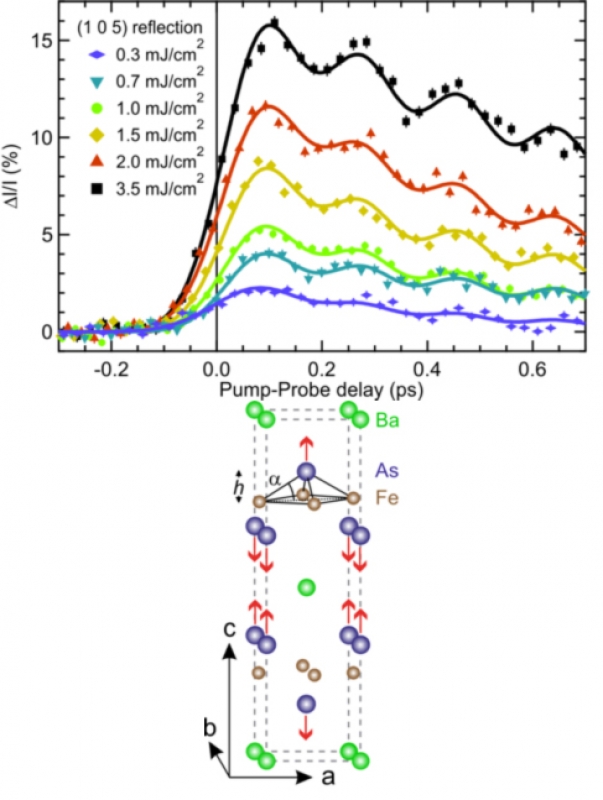Understanding the interplay of electrons, spins and lattice is essential for many complex materials, including the high-temperature superconductors
February 13, 2015Ultrafast Structural Dynamics of the Fe-Pnictide Parent Compound BaFe2As2
Understanding the interplay of the various degrees of freedom such as the electrons, spins and lattice is essential for many complex materials, including the high-temperature superconductors. In the case of the Fe pnictides, especially the strong sensitivity of the electronic and magnetic properties to the exact shape and size of the Fe-As tetrahedra (Fig. 1, left) plays a crucial role for superconductivity and demonstrates a strong magneto-structural coupling. In addition, antiferromagnetic phases are closely linked to structural distortions in these materials.
Here, we use femtosecond time-resolved x-ray diffraction at FEMTO to investigate the structural dynamics in the Fe-pnictide parent compound BaFe2As2. We observe fluence dependent intensity oscillations of two specific Bragg reflections with a period of ~200 fs (Fig. 1, right). Their distinctly different sensitivity to the pnictogen height h demonstrates the coherent excitation of the A1𝑔 phonon mode and allows us to quantify the coherent modifications of the Fe-As tetrahedra. By a comparison with time-resolved photoemission data we derive the electron-phonon deformation potential for this particular mode, which is comparable to theoretical predictions. Our results demonstrate the importance of this structural degree of freedom for the electron-phonon coupling in the Fe pnictides and indicate a transient increase of the Fe magnetic moments on an ultrafast timescale.
In addition, in the spin-density wave ground state we investigate the reduction of the orthorhombic distortion by the laser excitation. The orthorhombic splitting of the Bragg reduces on a timescale of several tens of picoseconds, compatible with domain motion. This contrasts with the ultrafast quench of the magnetic ordering in <200 fs and provides further information about the coupling of magnetic and structural degrees of freedom.

Figure 1. Top: Pump-induced change of diffraction intensity of the (1 0 5) reflection. Bottom: Structure of BaFe2As2 with the motion pattern of the A1g phonon mode (red arrows).
Reference: Rettig, L, S O Mariager, A Ferrer, S Grübel, J A Johnson, J Rittmann, T Wolf, S L Johnson, G Ingold, P Beaud, and U Staub, Ultrafast Structural Dynamics of the Fe- Pnictide Parent Compound BaFe2As2. Phys. Rev. Lett., (2015) 114: 067402 (10.1103/PhysRevLett.114.067402)
 Rettig-2015
Rettig-2015back <<

 Ursula Keller wins “Swiss Nobel” Marcel Benoist Prize
Ursula Keller wins “Swiss Nobel” Marcel Benoist Prize Farewell: the NCCR MUST ended
Farewell: the NCCR MUST ended  MUST2022 Conference
MUST2022 Conference New scientific highlights
New scientific highlights FELs of Europe prize for Jeremy Rouxel
FELs of Europe prize for Jeremy Rouxel Ruth Signorell wins Doron prize
Ruth Signorell wins Doron prize New FAST-Fellow Uwe Thumm at ETH
New FAST-Fellow Uwe Thumm at ETH International Day of Women and Girls in Science
International Day of Women and Girls in Science New scientific highlight
New scientific highlight EU XFEL Young Scientist Award for Camila Bacellar,
EU XFEL Young Scientist Award for Camila Bacellar, Prizes for Giulia Mancini and Rebeca Gomez Castillo
Prizes for Giulia Mancini and Rebeca Gomez Castillo Nobel Prize in Chemistry awarded to RESOLV Member Benjamin List
Nobel Prize in Chemistry awarded to RESOLV Member Benjamin List Hans Jakob Wörner invited to give the „New Horizons Solvay Lectures”
Hans Jakob Wörner invited to give the „New Horizons Solvay Lectures”  Unusual keynote talk at an international scientific conference
Unusual keynote talk at an international scientific conference NCCR MUST at Scientifica 2021
NCCR MUST at Scientifica 2021